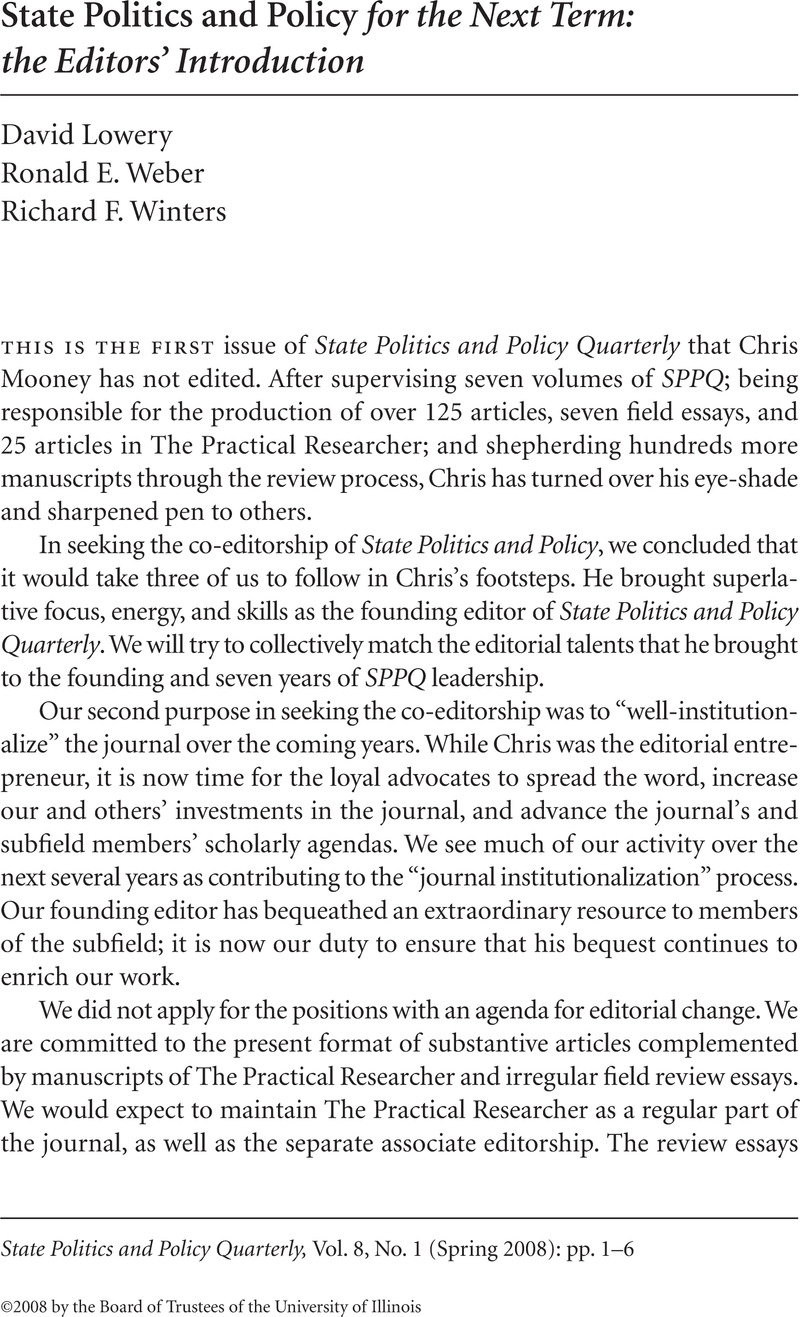No CrossRef data available.
Article contents
State Politics and Policy for the Next Term: the Editors' Introduction
Published online by Cambridge University Press: 25 January 2021
Abstract
An abstract is not available for this content so a preview has been provided. Please use the Get access link above for information on how to access this content.

- Type
- Introduction
- Information
- Copyright
- Copyright © 2008 by the Board of Trustees of the University of Illinois
References
Anton, Thomas. 1966. The Politics of State Expenditure in Illinois. Urbana, IL: University of Illinois Press.Google Scholar
Brace, Paul, and Hall, Melinda Gann. 1995. “Studying Courts Comparatively: The View from the American States.” Political Research Quarterly 48:5–29.CrossRefGoogle Scholar
Brace, Paul, and Jewett, Aubrey. 1995. “The State of State Politics Research.” Political Research Quarterly 48:643–81.CrossRefGoogle Scholar
Bryan, Frank. 1974. Yankee Politics in Rural Vermont. Hanover, NH: University Press of New England.Google Scholar
Chubb, John. 1988. “The Political Economy of Federalism.” The American Political Science Review 79:994–1015.CrossRefGoogle Scholar
Cook, Thomas D., and Campbell, Donald T.. 1979. Quasi-experimentation: Design & Analysis Issues for Field Settings. Chicago, IL: Rand McNally College Publishing Co.Google Scholar
Dawson, Raymond, and Robinson, James. 1963. “Inter-Party Competition, Economic Variables, and Welfare Policies in the American States.” The Journal of Politics 25:265–89.CrossRefGoogle Scholar
Dougherty, Keith. 2001. Collective Action under the Articles of Confederation. Cambridge, UK: Cambridge University Press.Google Scholar
Epstein, Leon. 1958. Politics in Wisconsin. Madison, WI: University of Wisconsin Press.Google Scholar
Erikson, Robert, Wright, Gerald, and McIver, John. 1993. Statehouse Democracy: Public Opinion and Policy in the American States. Cambridge, UK: Cambridge University Press.Google Scholar
Ferejohn, John, and Weingast, Barry, eds. 1997. The New Federalism: Can the States be Trusted? Stanford, CA: Hoover Institution Press.Google Scholar
Gray, Virginia. 1973. “Innovation in the States: A Diffusion Study.” The American Political Science Review 67:1174–85.CrossRefGoogle Scholar
Gray, Virginia, and Lowery, David. 1996. The Population Ecology of Interest Representation: Lobbying Communities in the American States. Ann Arbor, MI: University of Michigan Press.CrossRefGoogle Scholar
Jewell, Malcolm. 1982. “The Neglected World of State Politics.” The Journal of Politics 44:638–57.CrossRefGoogle Scholar
Kovenock, David, and Prothro, James. 1973. Explaining the Vote. Chapel Hill, NC: Institute for Research in the Social Science.Google Scholar
Lane, Robert. 1962. Political Ideology: Why the American Common Man Believes What He Does. New York, NY: Free Press of Glencoe.Google Scholar
Loomis, Burdett. 1994. Time, Politics, and Policies: A Legislative Year. Lawrence, KS: University of Kansas Press.Google Scholar
Mooney, Christopher, 2001. “State Politics and Policy Quarterly and the Study of State Politics: the Editor's Introduction.” State Politics and Policy Quarterly 1:1–4.CrossRefGoogle Scholar
Riker, William H. 1964. Federalism: Origin, Operation, Significance. Boston, MA: Little, Brown.Google Scholar
Steiner, Gilbert, and Gove, Samuel. 1960. Legislative Politics in Illinois. Urbana, IL: University of Illinois Press.Google Scholar
Stults, Brian, and Winters, Richard F.. 2005. “The Political Economy of Taxes and the Vote.” Manuscript, Dartmouth College.Google Scholar
Tiebout, Charles M. 1956. “A Pure Theory of Local Expenditures.” The Journal of Political Economy 64:416–24.CrossRefGoogle Scholar
Volden, Craig. 2004. “Origin, Operation and Significance: The Federalism of William H. Riker,” Publius 34:89–107.CrossRefGoogle Scholar
Walker, Jack. 1969. “The Diffusion of Innovations Among the American States.” The American Political Science Review 63:880–99.CrossRefGoogle Scholar
Weber, Ronald E., Hopkins, Anne, Mezey, Michael, and Munger, Frank. 1971–72. “A Computer Simulation of Methodology for Estimating State Policy Preferences.” Public Opinion Quarterly 36:549–65.Google Scholar


